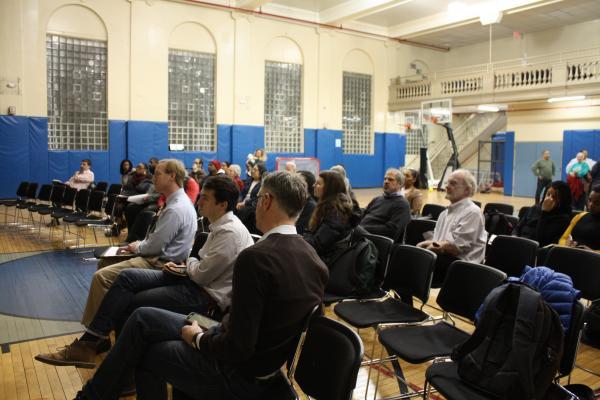February 23, 2017

Neighbors, abutters and city officials listened to a presentation about a proposed four story mixed-use development on Bowdoin Street that was discussed last Thursday night at the St. Peter’s Teen Center. Clara Hudson photo
A proposed four story mixed-use development on Bowdoin Street was discussed last Thursday night at a public meeting that drew roughly thirty people to the St. Peter’s Teen Center, where several residents raised their concerns about the potential building at 191-195 Bowdoin St.
The property would be built by the Vietnamese American Initiative for Development (VietAID) with the goal of providing affordable housing and employment opportunities. The plan is to build a 41 unit residential building, as well as 6,000 square feet for retail space on the ground floor. The building would have 13 1-bedroom, 23 2-bedroom, and 5 3-bedroom apartments.
The apartments would be affordable to households with incomes at 60 percent of the Area Median Income, while eleven apartments will be affordable to those making 30 percent of the Area Median Income.
The meeting began with a presentation by the developers, who covered topics ranging from parking to local representation and affordability.
“Here in Dorchester, the feeling is that rent is going upwards. If there are people that can afford to live here now, that may not be so true in the future,” said Eric Fellinger from VietAID. A community courtyard has been proposed for the site as well as parking for retail and residents. Currently, the land is being used as a temporary open space.
“One of the first things we do when we start a project is to get a feel for the neighborhood,” said Nick Buehrens, the project architect for Utile, Inc., the company hired to design the building. Buehrens said that understanding the character of the community is essential for the design process.
“We want to be very contextual and sensitive to the neighborhood that it’s in,” he said.
Affordability in the context of the immediate Bowdoin-Geneva section became a point of contention at the meeting. One woman wanted to know what data the development team was using to set affordability rates.
"What’s affordable? You know a lot of families in this area are earning $35,000 a year or less for a family of four,” she said. There will be a lottery process for the apartments, and a state rent subsidy that helps keep up the building and lower the costs for the tenant.
However, Bob Jones from the city’s Department of Neighborhood Development pointed out that, “people are always concerned about lower income levels in these projects. What they don’t realize is that there are a lot of folks doing better than this. Too many of these developments are pushing down the incomes,” he said.
Jones proposed more of a mixed range of incomes, with a few apartments at 80 percent of the Area Median Income.
Another suggestion came from a neighbor concerned about the size of the units.
“We need more familysized units. There are a lot of families in this neighborhood, particularly single mothers,” she said. “I was hoping that the retail store could be more reflective of the community by accommodating family businesses.”
The Dorchester Community Food Coop is a potential tenant for the retail space. A representative from the Coop said that the space could be innovative, incorporating new ideas for the neighborhood.
However, concerns about community representation came to a head when a show of hands proved that only a handful of those at the meeting actually lived around Bowdoin Street. Referencing the lack of locals present, Jones said “I live in this community, and every time I go to these meetings it’s mind boggling.”
The group suggested hiring a translator, as well as advertising meetings like this in many more languages to spread the word.
“The people that come to these meetings are predominantly English speakers. We need to clarify in every language what they [locals] need to do to be a part of this,” one attendee suggested. She went on to say that information on affordable housing is often complex, and in English, when Dorchester residents predominantly speak Creole, Spanish, and many more languages.
The meeting illuminated conflicting ideas between planners and nearby residents. For example, while some pushed for more parking to benefit the retail store, others disagreed, saying that there should be less parking because of nearby public transportation.
Another disagreement occurred over the height of the building, where a member of VietAID said that, “for every neighbor who wants it to go higher, there’s someone who wants it to be lower.”
VietAID called these compromises “a balancing act,” where community voices shape the conversation.
The Article 80 comment period, an initiative from the BPDA for public input, is set to end on Friday, Feb. 24.
Villages:
Topics:



